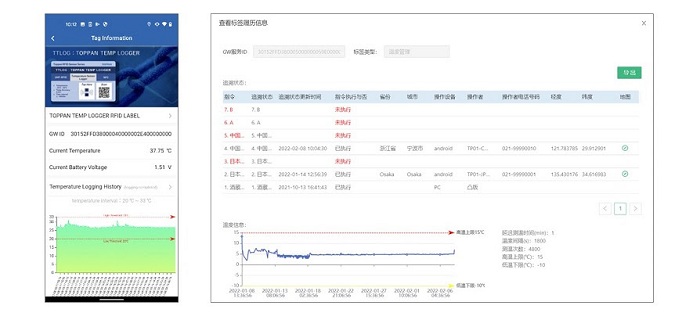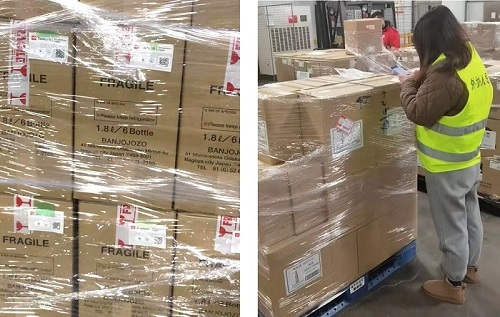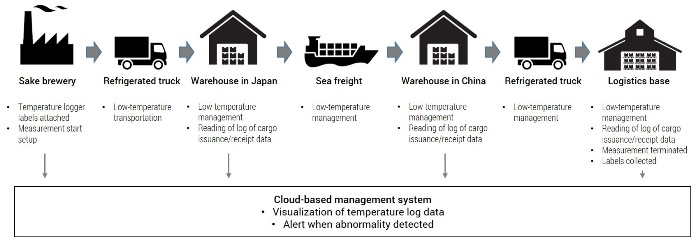Toppan, a global leader in communication, security, packaging, décor materials, and electronics solutions, has developed a thin, card-sized temperature logger label that enables temperature to be measured and recorded at regular intervals and data to be sent to a database via wireless networks.
When attached to freight, Toppan’s temperature logger label automatically records the surface temperature at an interval set by the shipper. Two frequency bands are available: UHF, which facilitates communication over relatively long distances of about five meters, and NFC, which is becoming increasingly incorporated into smartphones. Log data (record of date, time, temperature, etc.) from shipment to final destination or a given point on the route, which is read using a dedicated app, and traceability data from the reading location are sent to a cloud-based management system to facilitate chronological tracking and management of temperature changes during transportation.
Toppan’s temperature logger label is equipped with a single-use battery and adopts a simple structure without a terminal for data downloading or a display. Toppan therefore plans to supply it at less than one tenth of the cost of existing temperature logger devices.
The label was used as a tool to measure and record the surface temperature of container boxes during a pilot test conducted between October 2021 and March 2022, which involved transporting Japanese sake from major breweries in Japan to cold storage facilities in China. Sales of the temperature logger label are scheduled to be launched in June this year.
In contrast to general logistics, long-distance transportation of food requires strict temperature management. Fresh products such as meat, fish, and vegetables as well as chilled items such as dairy products and prepared foods need to be transported at specific temperatures set for each product to maintain freshness and prevent quality deterioration.
Temperature logger devices that measure and record temperature at fixed intervals are widely available as tools to manage temperature during transportation. Prices ranging from tens to hundreds of dollars per unit, however, mean that attaching them to every container is costly, and the workload for their recovery after use has also presented an obstacle to their adoption. This has led to increased demand for low cost temperature loggers suitable for one-way use that do not need to be recovered in scenarios requiring temperature management over long-distances, such as international shipping.
Features of Toppan’s temperature logger label
Simple structure and functions allow for a price that is less than one tenth of existing products
The structure and functions of the label have been made simple. It features an IC chip with a temperature sensor and a single-use battery, and a smartphone app is used to adjust settings. As a result, the price is less than one tenth that of existing temperature logger devices that include a control panel and assume replacement of the battery. This enables the label to be used in new ways, such as recording individual temperature changes of every container and one-way usage in which labels are not recovered after shipment is complete.
Measurement interval between one second and 60 minutes and timer function for start of measurement
Information recorded more than 38,000 times when measuring “temperature range”
Dedicated app for data reading and cloud-based system for managing temperature records
Toppan has enabled an integrated solution by developing a dedicated app to read the data saved in temperature logger labels and a cloud-based management system that makes records of temperature visible. The system is equipped with a series of features essential for temperature management during long-distance transportation, including an authentication function that prevents unauthorized access to temperature logger labels and a traceability function for managing the status of items being shipped.
“This solution dramatically reduces the cost of managing and visualizing temperature during long-haul transportation,” said Takamitsu Nakabayashi, senior R&D manager in Toppan’s security business. “The lower price of individual temperature logger labels means that the number used can be increased to facilitate more detailed and accurate measurement. The solution is also easy to introduce because labels can be read with smartphones, expanding the scope of quality control to a wider array of settings. Going forward, we will also combine it with our existing ID authentication platform to deliver an end-to-end service for optimizing the entire supply chain, including elements such as product verification, traceability, and enhancement of customer touchpoints.”

Specifications of Toppan’s temperature logger label
Temperature measurement range:
Number of times temperature can be recorded:
-Compressed mode: 14,592 times
-Limited mode: 38,912 times
(See explanation of temperature measurement modes above)
Period over which measurements can be taken:
Examples:
In case of 10-minute interval: 33 days
In case of 30-minute interval: 101 days
RFID communication protocols:
External dimensions (horizontal × vertical × thickness):
85.5 mm × 54 mm × approx. 1 mm
Pilot test by Japan’s Ministry of Agriculture, Forestry and Fisheries






















